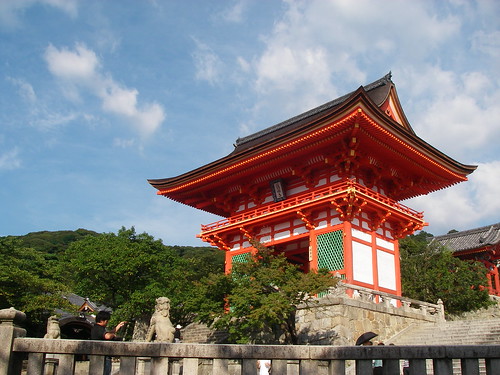A Walk in Kyoto
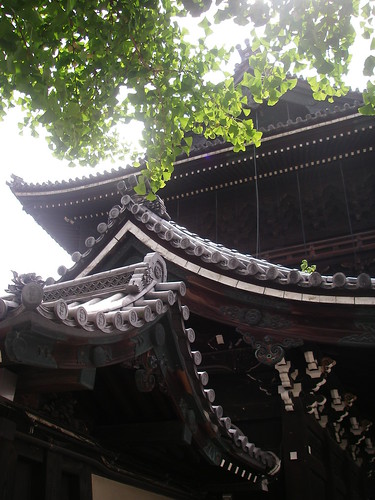
05/09/2007
I was lucky that today was Wednesday—even if that meant that I seem to have lost a day among all the partying.
Today, Mr. Hajime Hirooka, better known as Johnnie Hillwalker (“not Johnnie Walker!” as he says) would hold one of his thrice weekly walks from the station via some of the temples and shrines and through Kyoto’s backstreets up to the famous tourist areas which he reckons we can explore on our own, after the tour. And he is right.
Walking around Kyoto with Johnnie Hillwalker is one of the more interesting experiences of travelling in Japan. His quirky wit can be a little self-deprecating for comfort, but he is refreshingly opinionated. This became clear at the foot of the steps of Amida Hall at the mighty Higashi Honganji temple complex, the very first stop on the walk.
“Take off your shoes,” he said, pointing at the containers with plastic bags in which we would carry our shoes as we walked through the temple complex. “We Japanese are very nervous about our shoes!”
Gingerly, we stepped onto the chocolate-brown wood, worn smooth by centuries of bare or stockinged feet, and from there onto the cool tatami mats in the hall. A hush descended as we walked past the statue of the founder, Shinran Shonin—housed here while the Founder’s Hall is undergoing urgent repairs—and next to him the image of the Amida Buddha. A monk and a western woman sat in silent contemplation.
Johnnie waved us to one side and gave us a brief introduction to Shin Buddhism.
(paraphrased)
“The service is every morning. Ten minutes. Even so, no-one comes to temple. Or hardly ever. Instead we have family temples—9000 in Kyoto alone!”
He winked. “But we don’t have to worship even there. It doesn’t matter. —If you are American,” he pointed at a couple of con-goers in the back, “or Dutch, or German, or English—the Buddha pay no attention. If you are rich or poor, he pay no attention. If you are good—no attention. If you are evil,” he looked at our raised eyebrows, “—no attention.”
Muttering erupted. Johnnie held up a hand. “But if you die—he comes rushing! The Amida Buddha is the Buddha of Paradise. Everyone goes to paradise.”
We were asking why anybody would want to do good, if everyone goes to paradise, but he brushed it aside. The role of Shin Buddhism became a little clearer as we learned about the importance of remembering the dead in Japanese family life at several stages during the tour.
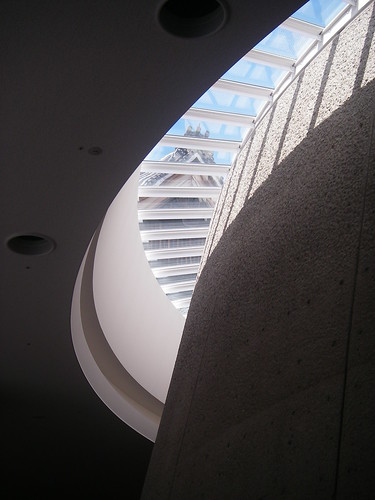
Johnnie Hillwalker did not get serious, even when that subject came up. “After seeing that everybody goes to paradise, Shinran Shonin, the founder of Shin-Buddhism, was out of a job. No need for monks or priests. So today, Buddhist priests are allowed to marry.” They support their families by visiting homes once a month, on the day of the death of the most recently deceased, to read scriptures and collect donations.
We moved on to the history of the buildings themselves, and Johnnie lamented the fact that Japan’s old capital was build entirely of wood. Fires razed it regularly. The Kyoto that was built a thousand years ago no longer stands. And the same is true for the mighty Founder’s Hall: it was last rebuilt in 1865. By that time, the power of the Shōgun had faded and the hall was built by volunteers who ventured into the mountains in their hundreds, bringing down mighty elms on large wooden sleds, towed through the snow with ropes made from human hair. Many of the devotees perished.
But even with a structure as mighty as this, the crowning glory of a Japanese building is its roof. And three years ago, the magnificent but heavy roof of the Founder’s Hall began to collapse. Since then, it has been under tarpaulins while the roof is painstakingly restored, using lighter tiles.
By this time, we had left the gangway that led past the hall, lined with imposing pillars shaped from entire trees, and entered the modern annexe. We’d had to keep moving to avoid congestion, although we were the only tourists around. As impressive as it is, Higashi Honganji is an active place of worship, rather than a tourist destination.
“In Japan, Buddhism does not take care of material needs,” Johnny said, continuing his crash-course in Japanese religions. “For that, we have Shinto.”
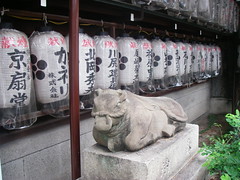
Each shinto shrine reflects a particular purpose, whether it is success in business or good health. The Ayako-tenmangu shrine is devoted to the latter; not just health in body, but also in mind. It gets very busy at exam times when students make their offerings.
Johnnie walked up to the rope designating the sacred area, tossed a few coins in the collection box, rung the bell and clapped once, sharply, to attract the attention of the spirits which dwell in the interior of the shrine (“—if they haven’t flown away,” he said. “That’s all. It’s a very easy religion!”). It also attracted the attention of the priest’s wife who came out to demand his annual membership dues. There is a lantern hanging on the temple wall in the name of ‘Johnnie Hillwalker’ and the walk.
So in Japan, Shinto and Shin-Buddhism exist side-by side. The Shinto priests take care of births and weddings, the Buddhist priests take care of the funerals. The Buddhist temples are not normally open to the public; one enters through a small side door into a tranquil garden and towards a cemetery at the back, filled with rows of near-identical stone graves. At their backs, wooden slats, or toba, stick out, placed there on every seventh anniversary of the deaths.
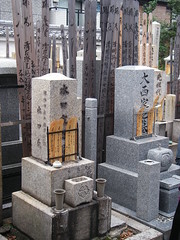
We walked on, along tiny back streets which—despite the flower pots in front of the houses—were not pedestrian zones as I found out when a passing car nearly flattened me against one of the walls. A lamp post saved me. The driver turned down the window and waved me past impatiently, which involved squeezing myself through the narrow orifice between the lamp post and the wall while he doubtlessly muttered something about “dumb tourists.”
So, we kept one eye on the traffic and another on the windows which Johnnie pointed out. Family-based workshops still abound in Kyoto’s backstreets, where anything from tatami mats to fans to kimonos is made. But Kyoto’s cottage industry has an Achilles heel. Cooperation between the families has always been tradition and one workshop might specialise in nothing but making paper for the fans, while another only deals with the printing, or the bamboo frames. Thus, even a single hand-made fan passes through more than one home. And a traditional kimono passes through no fewer than forty. The problems arise when young people leave, no longer interested in the life of an artisan, which is poorly paid and monotonous.
Kyoto is slowly dying from the inside.
On Shomen Dori, we passed an unassuming building: the former headquarters of the Nintendo playing card company. They have since moved on to better things, and bigger premises.
Behind the building lies one of Kyoto’s old Geisha quarters. But unlike the famous Gion quarter, government assistance came too late and few Geisha remain in Gojo. Aside from festivals, you’ll be hard pressed to spot a geisha or meiko anyway—apart from the pretenders who are being made up in the geisha costume shops off Shijo Dori. By that time I was too famished to stop for pictures (the walk does not include a lunch stop).
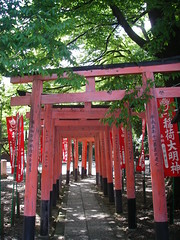
We finished at Toyokuni shrine, built to honour Toyotomi Hideyoshi, the master negotiator and warlord who unified Japan.
This was Kyoto in a hurry. A seven-day rail pass simply does not leave enough time to explore: Kyoto is definitely worth a week on its own. I missed the original zen garden at Nanzenji Temple (and the original zen temple in the centre, Kenninji, which was closing when I got there), not to mention several dozen other amazing temples, shrines and gardens. I missed the nightlife: I wanted to explore those tiny back streets in the evening. Or go for that special meal I’d promised myself: ideally a proper kaiseki in a ryokan, but otherwise fugu, kobe beef or proper sushi, in that order. Only not on my own.
But tomorrow, irrevocably, it would be time to move on.
